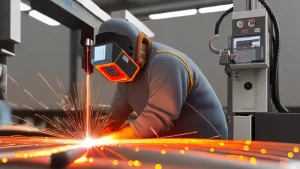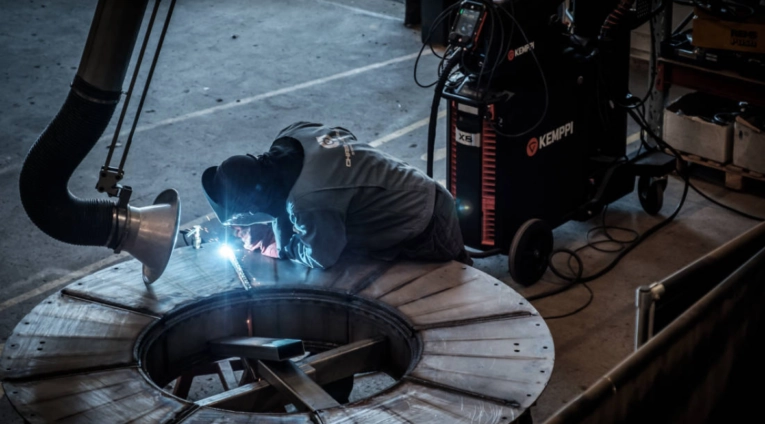Fiber laser welding, a remarkable technology in the electronics industry, is transforming the manufacturing and assembly of electronic components. Its role in this sector is undeniably crucial, offering numerous advantages over traditional welding methods.
In this article, we delve into the role of fiber laser welding in the electronics industry. We will discuss the importance of fiber laser welding in the electronics industry, where precision and efficiency are paramount. This cutting-edge technique utilizes a high-powered laser beam transmitted through an optical fiber, enabling precise and controlled welding of delicate electronic components.
By harnessing the power of fiber lasers, manufacturers achieve superior weld quality, minimal heat-affected zones, and reduced distortion, critical in electronic device production. Additionally, we will explore the electronic marvels achieved through fiber laser welding, enhancing the structural integrity of circuit boards and improving the reliability of electronic connections.
Join us as we unravel the fascinating world of fiber laser welding and its profound impact on the electronics industry.
Key Takeaways
- Fiber laser welding provides precise and efficient joining of electronic components.
- It offers high processing speeds for increased production rates.
- Fiber laser welding ensures strong and durable joints for integrity and functionality.
- It allows for the welding of a wide range of materials, making it versatile in the electronics industry.
Importance of Fiber Laser Welding in Electronics
Fiber laser welding plays a crucial role in the electronics industry by providing precise and efficient joining of electronic components. As electronic devices become more compact and intricate, the need for highly accurate and reliable welding methods becomes paramount.
Fiber laser welding meets these requirements by utilizing a focused laser beam to create welds with minimal heat input and distortion. This results in strong and durable joints, ensuring the integrity and functionality of the electronic components.
Additionally, fiber laser welding offers high processing speeds, allowing for increased production rates and cost-effectiveness. Its ability to weld a wide range of materials, including metals and plastics, further enhances its versatility in the electronics industry.
Advantages of Fiber Laser Welding in the Electronics Industry
One of the key benefits of utilizing fiber laser welding in the electronics industry is its exceptional precision in joining electronic components. With its high power density and focused beam, fiber laser welding allows for accurate and controlled melting of the materials, resulting in strong and reliable welds.
Advantages of fiber laser welding in the electronics industry include:
- Improved productivity: Fiber laser welding offers fast welding speeds, enabling manufacturers to increase their production rates and meet growing demands.
- Enhanced quality: The precise and controlled nature of fiber laser welding ensures consistent and high-quality welds, reducing the risk of defects or failures in electronic components.
- Minimal heat input: Fiber laser welding produces minimal heat-affected zones, minimizing the risk of damage to sensitive electronic parts and reducing the need for additional post-welding processes.
Applications of Fiber Laser Welding in Electronics Manufacturing
The application of fiber laser welding in electronics manufacturing plays a crucial role in ensuring the precise and reliable assembly of electronic components.
Fiber laser welding offers several advantages over traditional welding methods, making it an ideal choice for various applications in the electronics industry.
One of the key applications is the welding of delicate and intricate electronic components, such as microchips and circuit boards. Fiber laser welding provides a high level of precision, enabling manufacturers to achieve tight tolerances and avoid damage to sensitive electronic parts.
Additionally, fiber laser welding is capable of welding dissimilar materials, which is often required in electronics manufacturing. This versatility allows for the seamless integration of different components, enhancing the overall performance and reliability of electronic devices.
Enhancing Efficiency and Precision With Fiber Laser Welding
To further optimize manufacturing processes in the electronics industry, the implementation of fiber laser welding technology enhances efficiency and precision in the assembly of delicate electronic components. With its advanced capabilities, fiber laser welding offers several benefits:
- Improved Speed: Fiber laser welding enables faster welding times compared to traditional methods, reducing production cycle times and increasing overall productivity.
- Enhanced Precision: The focused laser beam allows for precise control over the welding process, resulting in accurate and consistent welds, especially for intricate electronic components.
- Reduced Heat Affected Zone: Fiber laser welding produces minimal heat, minimizing the risk of thermal damage to sensitive electronic parts and ensuring the integrity of the final product.
Overcoming Challenges in Fiber Laser Welding for Electronics
Despite the advancements in fiber laser welding technology, there are certain challenges that need to be overcome when it comes to its application in the electronics industry.
One of the main challenges is the precise control of the welding process. Electronics components are often small and delicate, requiring a high level of accuracy in the welding process to avoid damage.
Additionally, the heat generated during the welding process can cause thermal stress on the electronic components, which can lead to performance issues or even failure.
Another challenge is the need for a clean welding environment. Any contaminants present during the welding process can negatively impact the quality and reliability of the electronic components.

Finally, there is a need for effective heat dissipation during the welding process to prevent overheating and potential damage to the electronics.
Overcoming these challenges is crucial to ensure the successful integration of fiber laser welding in the electronics industry.
Future Trends and Innovations in Fiber Laser Welding for Electronics
In light of the challenges faced in fiber laser welding for electronics, there are emerging future trends and innovations that hold promise for the industry. These developments aim to address the current limitations and improve the overall efficiency and effectiveness of fiber laser welding in the electronics sector.
Some of the key trends and innovations include:
- Advanced Process Monitoring: The integration of real-time monitoring systems allows for better control and optimization of the welding process. This includes the measurement of key parameters such as temperature, power, and speed, enabling operators to make adjustments and ensure consistent quality.
- Automation and Robotics: The use of robotics and automation in fiber laser welding offers increased precision and speed, reducing human error and improving productivity. Automated systems can handle complex welding tasks with minimal intervention, resulting in higher throughput and cost savings.
- Material and Design Innovations: Continuous research and development efforts are focused on developing new materials and designs that are more compatible with fiber laser welding. This includes the use of innovative alloys and coatings that enhance weldability and ensure reliable joint integrity.
These future trends and innovations are set to revolutionize the field of fiber laser welding for electronics, making it more efficient, reliable, and cost-effective.
Frequently Asked Questions
What Is the Role of Fiber Laser Welding in the Electronics Industry?
Fiber laser welding plays a crucial role in the electronics industry by providing precise and efficient welding solutions. Its ability to create strong and reliable connections between electronic components contributes to the production of high-quality electronic devices.
What Are the Advantages of Using Fiber Laser Welding in the Electronics Industry?
Fiber laser welding offers numerous advantages in the electronics industry. It provides precise and controlled welds, resulting in stronger and more reliable connections. Additionally, it allows for faster production speeds and reduces the risk of damage to delicate electronic components.
How Is Fiber Laser Welding Applied in the Manufacturing of Electronics?
Fiber laser welding is widely used in the manufacturing of electronics due to its precision and speed. It allows for precise welding of small components, such as circuit boards, resulting in efficient and reliable electronic devices.
How Does Fiber Laser Welding Enhance Efficiency and Precision in the Electronics Industry?
Fiber laser welding enhances efficiency and precision in the electronics industry by providing a high-energy beam that can produce clean, precise welds on small electronic components. This technology allows for faster production times and improved product quality.
What Are the Challenges Faced in Fiber Laser Welding for Electronics and How Are They Overcome?
The challenges faced in fiber laser welding for electronics include thermal management, material compatibility, and process control. These challenges are overcome through advanced cooling systems, optimized materials, and real-time monitoring and adjustment of welding parameters.
Conclusion
In conclusion, fiber laser welding plays a crucial role in the electronics industry by offering precise and controlled welding of delicate components. It provides numerous advantages such as superior weld quality, minimal heat-affected zones, and reduced distortion.
Through this technology, advancements in miniaturization, durability, and overall performance of electronic devices have been achieved.
Despite challenges, the future of fiber laser welding in electronics looks promising, with ongoing trends and innovations aimed at further enhancing efficiency and precision in manufacturing processes.
You May Also Like:
